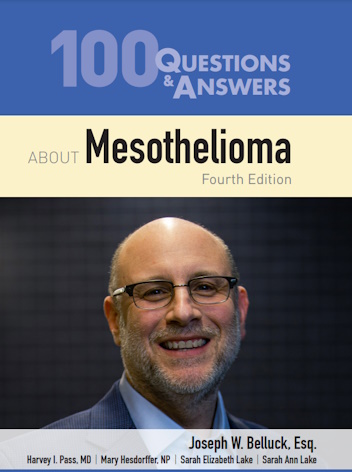Written by:
Harvey Pass, MD, NYU Langone
Mary Hesdorffer, NP, (Retired) Mesothelioma Applied Research Foundation
Joseph Belluck, Esq., Belluck & Fox, LLP
Sarah Elizabeth and Sarah Ann Lake

4th Edition: Includes immunotherapy, CAR-T cell therapy, and the new staging system, plus:
- Types of mesothelioma
- Risk factors
- Symptoms
- Diagnosis
- Psychosocial support for patients and family members
- Legal options for mesothelioma patients
- Financial compensation and other assistance
- Choosing the right treatment
- Side effects of treatment
- Likeliness of a recurrence and treatment options
- Caregiver information
Have you or a loved one been diagnosed with mesothelioma?
If you are reading this page, you or someone you love has probably been recently diagnosed with mesothelioma ─ a serious cancer caused by exposure to asbestos. You may wonder what this means for you and your family. If you are overwhelmed by questions about treatment options, prognosis, finances, and legal rights, that’s normal. But you’ve come to the right place.
What is mesothelioma?
Mesothelioma is a cancer of the lining of the lung, abdomen, heart or testes. These
organs are surrounded by a thin membrane made up of mesothelial cells, called the
mesothelium – hence the name “mesothelioma.” Symptoms vary depending on the
location of the cancer.
The most common type is pleural mesothelioma. This type of mesothelioma grows on
the lining of the lung. Symptoms of pleural mesothelioma include:
- fluid between the lining and the lung (also called a pleural effusion);
- shortness of breath (also known as dyspnea);
- chest pain;
- weight loss;
- low grade fever and night sweats;
- cough.
The second most common type of mesothelioma is peritoneal mesothelioma. This type
of mesothelioma proliferates on the lining of the abdomen (peritoneum). Symptoms of
peritoneal mesothelioma include:
- increased abdominal size;
- fluid in the abdomen (ascites);
- abdominal pain;
- digestive issues;
- low grade fever;
- leukocytosis (elevated white blood cells).
The only known cause of mesothelioma is asbestos exposure. The period between exposure to asbestos and disease development generally takes anywhere between 20 – 50 years.
Whether you, a loved one, or someone you know has been diagnosed with mesothelioma, so many questions surrounding compensation, life expectancy, and treatment options come to mind. We help caregivers and patients understand their rights and get the help they need during this difficult time.
We’d like to offer you a free copy of 100 Questions & Answers About Mesothelioma; co-authored by our very own Joe Belluck.
Risk Factors
Occupational Exposures at Work
For many decades, asbestos was used in a wide variety of industrial, commercial, and household products. These include fireproofing materials, valves, pumps, gaskets, boilers, automotive brakes, textile products, electrical products, building materials, and more.
Millions of Americans who worked with or in the vicinity of asbestos materials were at risk of exposure. Companies did not warn workers of the risk, and employers did not take proper prevention measures and safety precautions to protect them from inhaling dangerous asbestos fibers in the air. Anyone in an area where asbestos materials were being handled was at risk of being exposed.

Some of the occupations that make it more likely for a person to have been exposed to asbestos include, but are not limited to:
- Construction workers
- Electricians
- Engineers
- Factory workers
- Laborers
- Plumbers
- Maintenance workers
- Mechanics
- Merchant seamen
- Navy service members
- Powerhouse workers
- Shipyard workers



Some of the industries where a person may have been exposed to asbestos include, but are not limited to:
- Shipbuilding;
- Navy service;
- Construction;
- Oil and chemical;
- Power plant;
- Railroad;
- Automotive;
- Steel – metal;
- Asbestos manufacturing;
- Papermill;
- Ceramics.
Take-home asbestos exposure
Is it possible to be exposed to asbestos and develop mesothelioma if you’ve never worked in these occupations?
Unfortunately, the answer is “yes.” Frequently, workers exposed to asbestos would bring home asbestos fibers on their clothing, hair and skin therefore exposing their spouses and children. This is known as “take-home” or secondhand asbestos exposure.
Other exposures
During the peak of asbestos use in the United States, over 30 million tons of asbestos were introduced into our environment, most of it still present in homes, office buildings, apartment buildings, schools, places of worship, and other buildings built before the 1990s.
Common construction products containing asbestos include:
- Plaster
- Tiles
- Cement
- Textured coatings and paints sometimes known as “popcorn ceiling”
- Joint compound
- Roofing materials
- Insulation
Facts and Information
After a mesothelioma diagnosis, the first thing many families do is research the facts and statistics about the disease. They want to know what caused it, what the treatment options are, and how they can get the help they need.
Some of the facts you should know include:
- The rate of mesothelioma cases is much higher among men than women (likely because of the occupations that were most at risk employed men).
- Mesothelioma is more commonly diagnosed in white and Hispanic/Latino people than in African Americans or Asian Americans.
- The average age for diagnoses of pleural mesothelioma is 69 years old.
- Many mesothelioma patients are veterans. Asbestos products were heavily used in all branches of the military, in particular the Navy.
- Asbestos, the only known cause of mesothelioma, is still present in our homes, buildings, and schools built prior to 1990, and still poses a significant risk for exposure.
Frequently Asked Questions
How does asbestos cause mesothelioma?
People who are exposed to asbestos typically inhale tiny fibers that lodge themselves into the pleural tissue lining the lungs and coating the chest wall.
These asbestos fibers can cause cellular changes and may cause irritation and inflammation in the pleura for many years before malignant pleural mesothelioma develops.
In some cases, people ingest rather than inhale the microscopic asbestos fibers, which can then become lodged in the tissue lining the abdominal cavity and organs.
This can eventually cause peritoneal mesothelioma, also known as abdominal mesothelioma.
In rare cases, asbestos fibers reach the tissue lining the heart or the testicles, resulting in pericardial or testicular mesothelioma.
How dangerous is asbestos?
Asbestos poses a serious health hazard to anyone exposed to it.
Since the 1970s, the U.S. government has been working to reduce the use of asbestos-containing materials and has implemented asbestos safety precautions for workers who may come into contact with the deadly material. And there is no safe level of exposure.
Asbestos exposure can lead to a number of serious diseases.
Is there a test for asbestos exposure?
Although there are no screening tests yet, if you know or suspect that you have been exposed to asbestos, you should talk to your doctor about having a chest X-ray once a year.
X-rays, CT scans, and MRIs can be used to help diagnose mesothelioma and other asbestos-related diseases early.
Also, cutting-edge blood tests (such as the MESOMARK blood test) have the potential to improve your chances of early detection.
Can adenocarcinoma be caused by asbestos?
Adenocarcinoma is a cancer that originates in glandular cells. According to the National Cancer Institute, most cancers of the lung, prostate, colon, pancreas, and breast are adenocarcinomas. Inhalation of asbestos fibers can cause adenocarcinoma in the lungs.
What is the difference between mesothelioma and asbestos?
Asbestos
Asbestos refers to a group of six fibrous minerals that occur naturally in the environment.
These minerals have been used heavily prior to 1990 in many industrial applications, construction, and household products.. It is estimated that over 30 million tons of asbestos were introduced into our environment over the last century. Asbestos is considered a dangerous carcinogen, which means it causes cancer.
Mesothelioma
A type of cancer caused by asbestos exposure.
What is the mesothelium?
The mesothelium is the membrane surrounding many of the body’s vital organs. This membrane secretes a lubricating fluid that allows the organs to move easily within the body.
This is where the cancer develops after asbestos is inhaled or ingested. The cancer that grows on the mesothelium is called mesothelioma. However, not all mesotheliomas are the same.
They are differentiated depending on their starting location, known as its origin site, and the type of tumor cells, known as its histological subtype. Different histological subtypes behave differently and can be more or less aggressive, thus often requiring a different treatment approach.
Can smoking cause mesothelioma?
Asbestos is the only known cause of mesothelioma. If you are a smoker who has been diagnosed, your doctor will urge you to quit immediately.
Why is malignant pleural mesothelioma the most common type of mesothelioma?
Most people are exposed to asbestos when fibers from asbestos-containing materials become airborne. This could happen when cutting, sanding, drilling, filing, or otherwise disturbing these dangerous materials. In the past, some workers also were exposed to raw asbestos, which was mixed with other materials to form products such as asbestos cement.
Airborne asbestos fibers could easily drift across an entire worksite, putting everyone in the vicinity at risk, not just those who were working directly with the material. This widespread exposure risk makes pleural mesothelioma the most common type of the disease.
Can mesothelioma be inherited?
No, malignant mesothelioma cannot be inherited, and it is not contagious. However, family members could have been exposed to asbestos secondhand (known as take-home asbestos) when those who worked with the material accidentally brought fibers home on clothing or uniforms.
Secondhand exposure to asbestos can cause mesothelioma.
Lung cancer vs. mesothelioma
People may confuse malignant mesothelioma with lung cancer. However, these are two separate types of cancer. Lung cancer is a carcinoma that affects the lung itself.
Is mesothelioma the same as lung cancer?
Mesothelioma is a cancer that attacks the mesothelial tissue that lines the lungs, chest cavity, and other organs in the body. Exposure to asbestos can cause both types of cancer, but it is the only known cause of malignant mesothelioma.
Asbestosis vs. mesothelioma
What is asbestosis disease?
Asbestosis disease is a non-cancerous chronic lung condition that is caused by inhaling asbestos fibers.
The asbestos fibers lodge in tiny sacs in the lungs, known as alveoli.
Symptoms of asbestosis include shortness of breath, tightness and pain in the chest, chronic cough, loss of appetite, weight loss, and clubbing of fingers and toes.
Treatment can include use of an oxygen tube or mask, pulmonary rehabilitation exercises, or a lung transplant in extreme cases.
Are asbestosis and mesothelioma the same?
No. Although both of these diseases, along with lung cancer, are associated with exposure to asbestos, they are not the same. Asbestosis is a chronic lung disease, not a cancer. It is caused by inhalation of asbestos fibers, which can get stuck in the small sacs in the lungs. Having asbestosis can increase a patient’s chances for developing asbestos-related lung cancer.
Malignant mesothelioma is a cancer. It affects the mesothelial tissue, which lines the lungs and chest wall, as well as the abdominal cavity, heart, and testicles. Malignant mesothelioma is caused by the inhalation or ingestion of asbestos fibers, which lodge in the mesothelial tissue.
100 Questions & Answers About Mesothelioma
100 Questions & Answers About Mesothelioma is committed to providing treatment information for those diagnosed with mesothelioma. This book offers help – whether you’re a newly diagnosed mesothelioma patient, a survivor, a friend, a relative, or a caregiver. It is written from a medical perspective and gives you authoritative, practical answers to your questions about treatment options, post-treatment quality of life, sources of support, legal options, and much more.
It’s time to get you information that you can trust.
When faced with a terrible diagnosis, it’s only natural that you want answers. Unfortunately, there is a lot of inaccurate information about mesothelioma, and you are likely overwhelmed with questions, fears, and conflicting information. We are confident that you will find the insights and resources in this book helpful, and that it will provide you with the answers that you need to understand mesothelioma.
